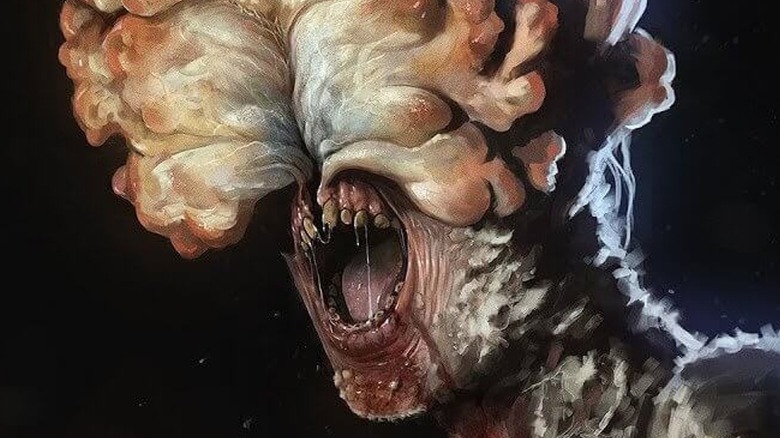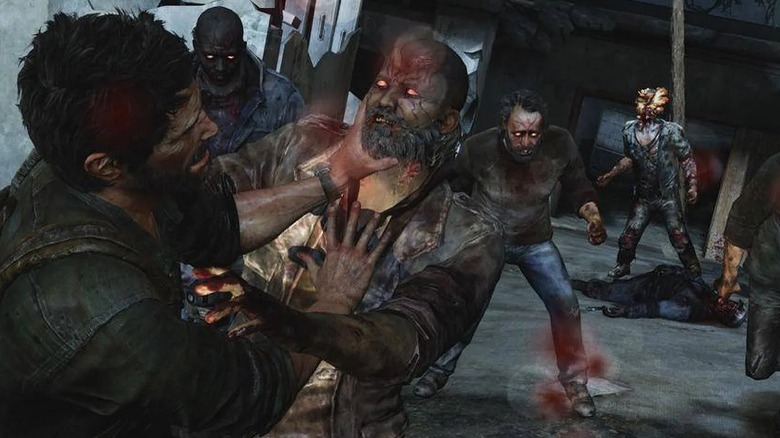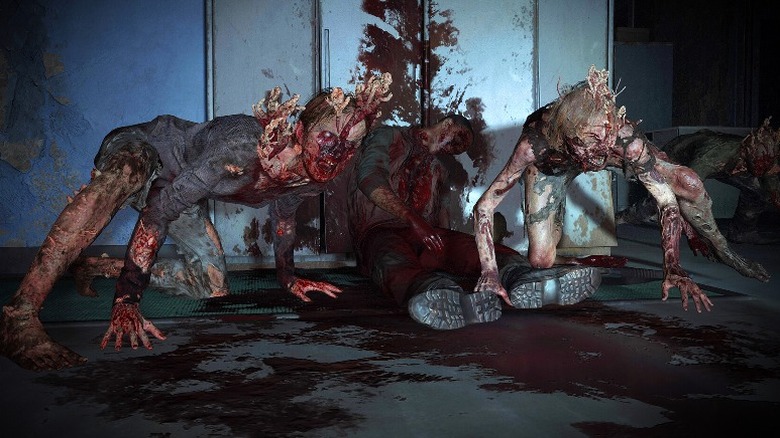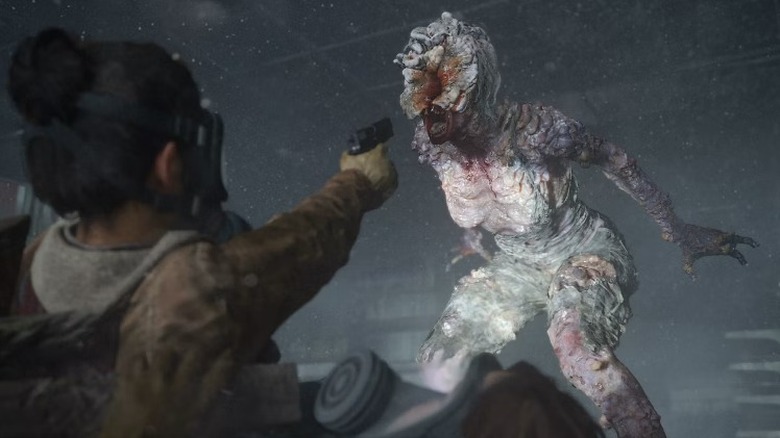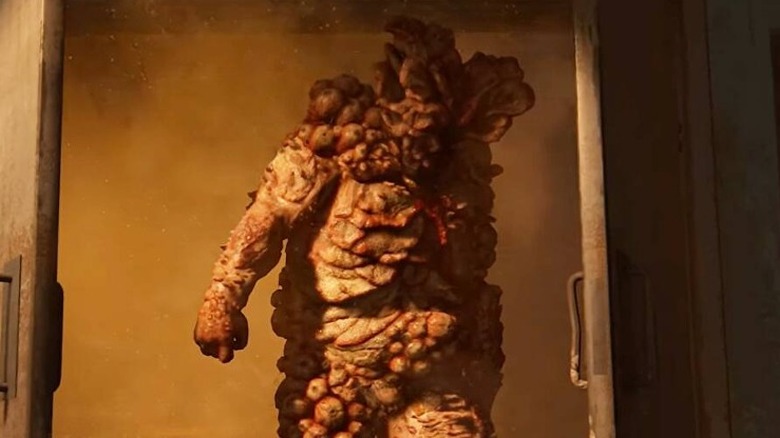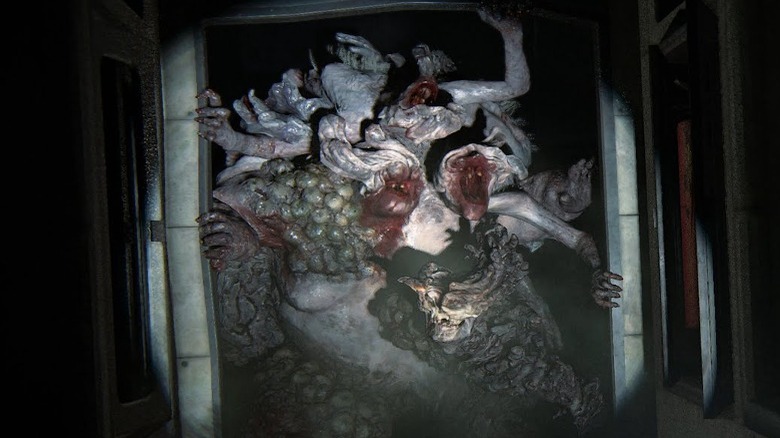The Last Of Us Infected Explained
"The Last of Us" takes a unique approach to the zombie apocalypse genre. Unlike the hordes of undead reanimated by a mysterious virus or a magical curse in other media, Naughty Dog's vision of a post-apocalyptic world is based on a real-life species of fungus called Cordyceps. This parasitic mushroom infects certain ants, caterpillars, and other insects, taking over their minds and forcing them to climb to the highest point they can reach so that the spores dispersed when the mushroom sprouts can spread as far as possible. The actual Cordyceps fungus is terrifying in the insect world, but it can't infect humans. Some people even consume certain species of it for its purported health qualities.
But that isn't the case in the world of "The Last of Us." In this timeline, humanity has been brought to the brink of extinction by the insidious mycelium and the only thing that has kept them alive so far are safe zones that enforce brutal quarantine practices and totalitarian resource management. Those who journey outside these zones risk running into bandits or the infected. The Cordyceps fungus can cause a variety of mutations, progressing in different ways as it grows within its host and ultimately resulting in several separate manifestations of the infection across four major stages.
Stage 1: Runner
The first type of infected host that players encounter in "The Last of Us" is called a Runner. A person turns into a Runner in the first stage of infection, with the change taking place just two days after exposure to Cordyceps, either through a bite or by breathing the mycelial spores. As their name suggests, Runners charge after noises and attempt to bite and kill anyone they encounter. They are relatively easy to take down compared to many of the more advanced mutations, however, and players grabbed by a single Runner can generally shake them off. Still, they should not be underestimated in large numbers. It takes time to get rid of a Runner, an opportunity the others will use to swarm players while pinned down.
Runners are the most human variety in appearance, though they are easily distinguished by the lesions on their faces, their milky eyes, and their generally sickly countenance. While inactive, players can typically find them hunched over and twitching. The noises they make can be unnerving since they sound much more human than most other types of infected. They can often be heard moaning or crying in pain as the fungus slowly works its way through their system. Don't be fooled, though. These poor souls have lost most, if not all, of the semblance of who they were before they were infected. Now their sole purpose is to eat and spread the infection.
Stage 2: Stalker
Runners that survive long enough will eventually reach the second stage of infection and become Stalkers. This can set in anywhere from two weeks to a year after the initial infection. These creatures seem to prefer dark places and areas near water. They tend to move around on all fours and can be visually distinguished from Runners by the stalks of Cordyceps that grow out of their faces and shoulders. They also make a disconcerting croaking sound that may indicate that they've lost much of the finer control of their vocal cords.
Stalkers are tougher than Runners and their behavior is significantly different. While Runners like to charge at their enemies out in the open, Stalkers prefer to take cover at the sight of a human. They hide in dark corners and attempt to spring from their hiding places to ambush prey as it passes rather than attacking it outright. Many sections in "The Last of Us" involve the player navigating dark and claustrophobic areas with Stalkers lying in wait. This can make them hard to deal with, as they constantly pop out of places players least expect. It's possible to shake off a Stalker's attack, but it's more challenging, and failure means instant death.
Stage 3: Clicker
Hosts turn into Clickers when they reach the third stage, after roughly one year of infection. Clickers are perhaps the most iconic breed of infected in the franchise due to their unique appearance and behavior. A host becomes a Clicker once the fungus has warped their bodies to the point that its growths have split through the front of its skull and covered the entire top half of its face. Terrifying to look at, they're also strong enemies. They can soak up a significant amount of ammunition before going down, and the only way to survive being grabbed by one is for the player to use up one of their precious shivs. Most of the time, players are better off avoiding confrontation with Clickers altogether if possible. That's easier said than done, though.
The only saving grace for players who encounter a Clicker is that the monstrous creatures are blind, the massive growths on their faces having obscured any remnants of vision. They make up for this with their impeccable hearing, however. The Clickers get their name from the unsettling clicking sounds they make, which they use as basic echolocation. This means that players who want to avoid combat with them will have to keep their distance while remaining silent. Bumping into a piece of furniture or knocking over a bottle is all it takes for every Clicker in the room to attack.
Stage 4: Bloater and Shambler
There are two possible ways that an infected can evolve past a Clicker. The first thing they can turn into is called a Bloater, massive creatures so overgrown with Cordyceps that they have developed a sort of fungal armor that covers their body, adding extra protection. They are often used as mini-bosses for areas. They're slow compared to other types of infected but are very strong. They can rip survivors like Joel, Ellie, and Abby apart with their bare hands. Unlike with Clickers and other infected, being grabbed by a Bloater is an instant death sentence. Maintaining too much distance can also be dangerous, though, as they will throw sacks of mycotoxin harvested from their bodies that explode on impact.
The other type of infected a Clicker can turn into is a Shambler. These walking piles of pustules made their debut in "The Last of Us Part 2" and were not present in any of the regions explored in "Part 1." Many people theorize that the infection manifested differently in these creatures than in ordinary Bloaters due to the heavy amounts of moisture in the Seattle area where the majority of the second game takes place (per Roanoke Gaming). Game creator Neil Druckmann himself has stated that the environment played a role in this alternate evolution. They are similar to Bloaters, except they shoot spurts of mycotoxin and release an explosive toxic cloud when players get too close or they are defeated.
Anomaly: Rat King
The final variation of infected doesn't come from one of the typical stages of Cordyceps infection. The Rat King is a unique enemy Abby faces in "The Last of Us Part 2." In real life, a Rat King is when a group of rats or mice get their tails tied into a knot and must learn to function as if they were a single organism to survive. It's a rare occurrence, and science has yet to determine how it happens, but a common theory is that their tails get tangled after being frozen or otherwise adhered together when groups of them pack into small spaces to stay warm in the winter (per Mental Floss).
In "The Last of Us," Abby encounters an enemy that appears to be comprised of multiple Stalkers and Clickers that have fused with a single Bloater. The Rat King is easily the toughest form of infected in either game. It's stronger and more resilient than a bloater, able to crash through solid walls, withstand multiple direct melee attacks, and discharge acidic clouds when players get too close. There is also a point in the battle where a piece of the Rat King resembling something between a Stalker and a Clicker breaks off and fights independently of the whole. The one that Abby battles in the basement of the Seattle hospital is the only one that has been introduced in the series ... so far.

